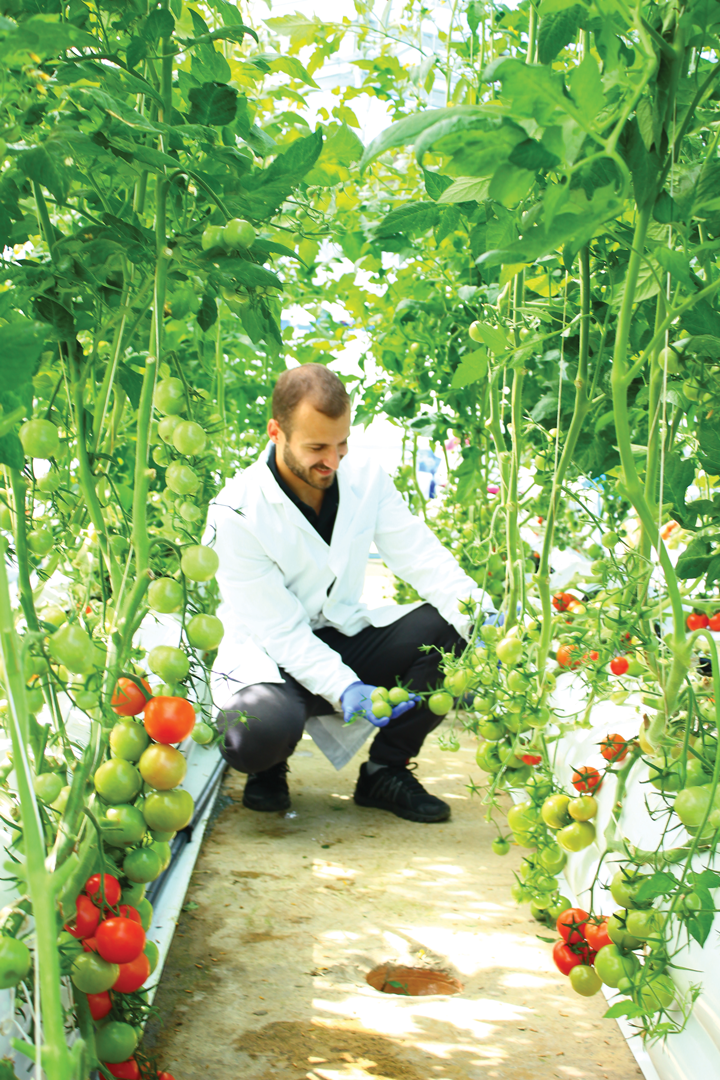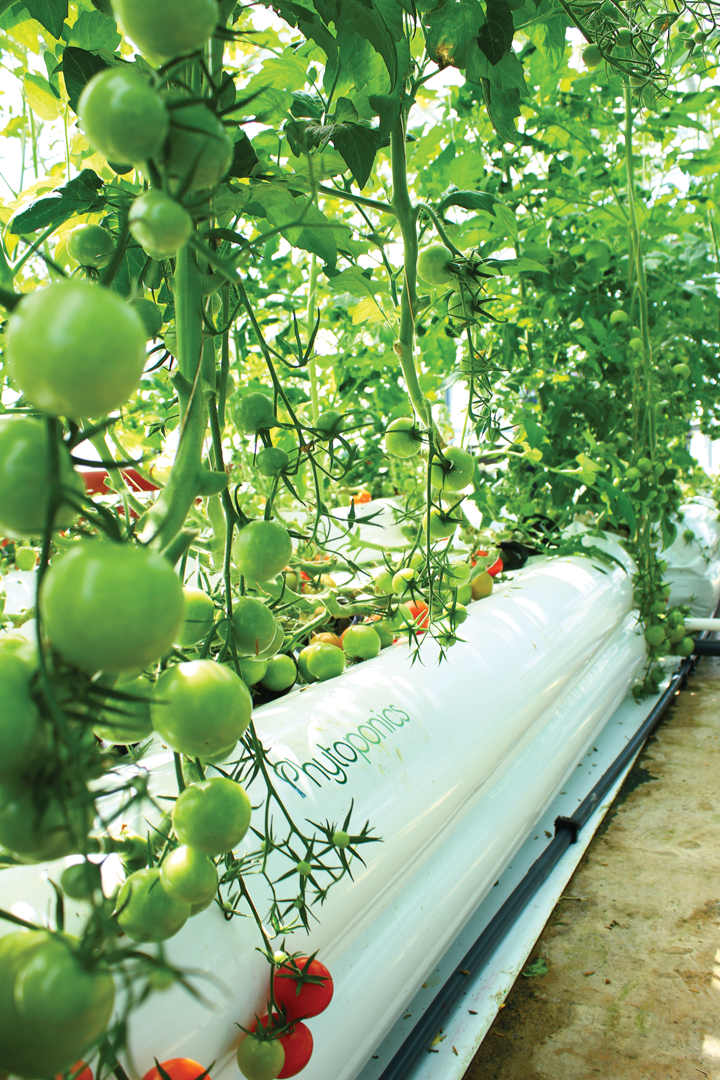Ditch the Dirt
IN the last century the human population has grown from 1.5bn to 6bn people. This explosive change was only possible due to an equally staggering increase in food supply. So far, agricultural yields have kept pace with the population, but at the cost of considerable ecological damage. The population is set to grow by another 2.5bn in the next 30 years – an increase that today’s technology will fail to match whilst destroying the environment. A drastic set of changes in our approach to farming is required to feed our species and preserve our precious planet.
The problems: land, water, fertiliser
Existing farmland is losing its fertility. Clearing natural vegetation to make space for agriculture removes the essential network of roots that holds dirt in place. The remaining layer of unsecured topsoil is stripped back by wind and water, leaving a barren desert. A way to keep yields constant through declining fertility is to simply create more farmland, something that has been achieved in some areas through the destruction of virgin habitats, including rainforests. This will not successfully meet future demand. To state the obvious, we do not have an infinite area of land that we can keep clearing for agriculture. Additionally, destroying the ‘lungs of the earth’ is probably accelerating climate change, increasing water scarcity in equatorial areas and encouraging desertification – a negative feedback loop we should avoid at all costs.
Over 70% of all freshwater is already devoted to agriculture. If we try to feed the population in 2050 through traditional growing methods we will run out of water
The negative effects of desertification will be multiplied by water scarcity. Over 70% of all freshwater is already devoted to agriculture. If we try to feed the population in 2050 through traditional growing methods we will run out of water.
The water use efficiency of soil farming is very low. It is estimated that 80% is lost to evaporation or is not actually absorbed by the plant roots. Water and land scarcity will only worsen through our growing consumption of meat, fuelled by the purchasing power of the new middle classes of young superpowers. In 2013, the University of Illinois, US calculated that China now consumes nearly twice as much pork per person than the US. The cost of water will only rise over the next 30 years, fuelling the value of more resource-efficient growing technology.
Land fertility has been boosted via excessive fertiliser use, which has again damaged the environment. Like water, the efficiency with which fertilisers are absorbed by plants is low – much ends up in local water systems, stimulating blooms of algae. The algae then die en masse, providing nutrition to a biblical concentration of decomposing bacteria. These microorganisms consume all available oxygen, creating anoxic ‘dead’ water, in which no other organisms can survive. The World Resources Institute identified over 130 separate hypoxic coastal zones along the coasts of the US, whose inability to support life was directly linked to fertiliser pollution.
The first revolution of food production saw farming go bigger, with more land, huge machinery and excessive use of natural resources. The second farming revolution is desperately needed where methods go smarter, with new technology facilitating an increase in the efficiency of land use, energy consumption and distribution of food.
Phytoponics: smart growing
In 2015 I was completing my Master’s in design engineering. A keen horticulturalist with industrial experience in growing technology, I began to research cutting edge agricultural practices. What caught my eye in particular was hydroponic systems, technology that facilitates the growth of plants without soil. The fundamental concept is that the roots of the crop are held in proximity to an oxygen- and nutrient-rich solution, which ultimately improves growth rates using less resource. Despite the potential benefits of such systems, I realised there were major improvements to be made on current designs, as existing setups were expensive, complicated and difficult to use, which put growers off from adopting this more sustainable technology. Determined to bring a more commercially-viable product to market, I dropped out of my PhD in 2016 to co-found Phytoponics.

Fast forward to 2017, I was nominated as the United Nations Environment Young Champion of the Earth for Europe. In November this year, we are finishing our first field trial in Wales, expecting a bumper yield of tomatoes. We have also signed a contract with a renowned UK crop grower to commence a full-scale commercial trial in 2019. So how did we do it?
A key design focus was to keep the cost of the system as low as possible. We achieved this by building the system out of a low-cost and flexible polymer, instead of more expensive, rigid materials. Plastic is a difficult material to work with at the best of times and the brief was challenging – the team needed a mould that was structurally sound, specifically shaped, and completely water-tight. Countless prototypes failed as the team initially fiddled with pond liner armed only with hairdryers. It took us six months to find the right polymer and shape that was even capable of growing a plant. However, with perseverance, we invented the patent-pending Hydrosac. Likened to a “jacuzzi in a bag”, the Hydrosac inflates and is connected to a power source and pump. The bag is partially filled with a nutrient solution, on top of which sit integrated 10 cm-long flotation chambers. These chambers contain seeds or immature plants. An in-built aerator at the bottom of the bag bubbles air through the nutrient solution. These bubbles burst at the surface, creating a nutrient and oxygen-rich spray that is absorbed by the plant. As the plant matures, its roots grow directly into the solution, facilitating the uptake of water and nutrients required for rapid growth. The Hydrosac is thus classified as a “deep water culture” growing system, due to the roots becoming fully submerged over time.
The second farming revolution is desperately needed where methods go smarter, with new technology facilitating an increase in the efficiency of land use, energy consumption and distribution of food
The technology could help feed a growing population. Like other hydroponic systems, the Hydrosac is able to grow produce far faster than achievable in soil, due to the high concentration of nutrients in the broth. A well-managed system can see yields 20 times more than growing in soil, as we have experienced during our early trials. If combined with a greenhouse, crop production becomes climate resilient, which means multiple harvests can be grown year-round, with less reliance on seasons. Unlike fields, the same crop can be grown repeatedly in a hydroponic system without a drop off in yield.
Our system requires a fraction of the water and fertiliser used by conventional farming. The Hydrosac is connected to a pump which recirculates the nutrient solution. This improves the efficiency of both water and fertiliser use as any substances not initially absorbed by the plant roots are simply recirculated. Additionally, the enclosed container prevents the mass evaporation of water seen in soil farming. Compared to conventional farming a hydroponic system uses on average 1/10th of the water and 1/4 of the fertiliser to produce the same yield. What little fertiliser is used cannot leave the system, preserving the surrounding environment.
Perhaps most importantly, the system requires no fertile land to grow crops. Our current field trial is growing a batch of tomatoes on a concrete floor in Wales. Not only does this reduce the demand for land clearance, taking pressure off the earth’s natural resources, it allows crops to be grown more locally than ever, providing fresher food with fewer transportation miles to urban areas.

The issue with technology
The advantages already mentioned are not necessarily independent to Phytoponics. Hydroponic farming is recognised as a method with which higher yields can be achieved using less resource and without fertile land. At a glance the benefits to a grower seem obvious, so why isn’t this technology more widespread?
The systems are traditionally expensive to acquire and install. Potential growers may decide that profits through resource efficiency and increased yield will recoup investment too slowly to be worthwhile. Even if they believe they could make their money back in a satisfactory period, an unforeseen setback would leave them with high levels of debt.
Although still in development, we expect our system to be cheaper than traditional hydroponic systems, mainly due to the nature of the low-cost flexible polymer used in the Hydrosac.Despite being cheaper, the polymer is extremely durable and completely resistant to corrosion. The system also contains numerous fail-safes in its automated nutrient delivery system.
If installation and transport are both costly it puts pressure on a grower to go full scale or incur extra costs of delivering and installing the systems incrementally. This increases investment required, putting off customers.
Our system is quick and easy to install. The bag deflates, meaning it can be flat packed and shipped globally at a low cost, whilst also reducing the carbon footprint of the product. Once at its destination it simply needs to be unrolled, inflated and connected to the farm’s resources. Growers can scale their operations at will, reflecting consumer demand, or simply start with a small trial run and then scale up when they feel confident to expand.
The future
The invention of hydroponic systems was the first step in a much-needed evolution in growing technology. Initial designs have focussed heavily on meeting the conceptual demand of growing a crop without soil. As our ability to grow improves over time, we believe the second step is making this technology as accessible and commercially viable as possible.
We will continue to partner with third parties, such as Covestro, whose experts in material science, energy efficiency, system design, data aquisition and analysis (including artificial intelligence) can help us deliver our vision.
We hope that this more productive and sustainable farming method will become widespread, and impact the world positively.
In 2018 Phytoponics received more than £400,000 (US$518,000) of investment to develop and commercialise its technology, and has won several awards since startup.
Recent Editions
Catch up on the latest news, views and jobs from The Chemical Engineer. Below are the four latest issues. View a wider selection of the archive from within the Magazine section of this site.




